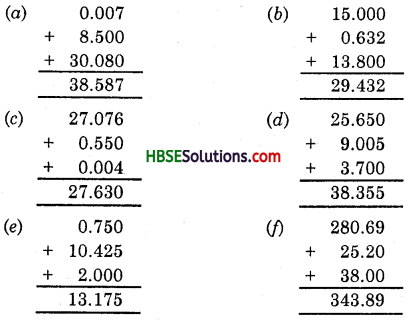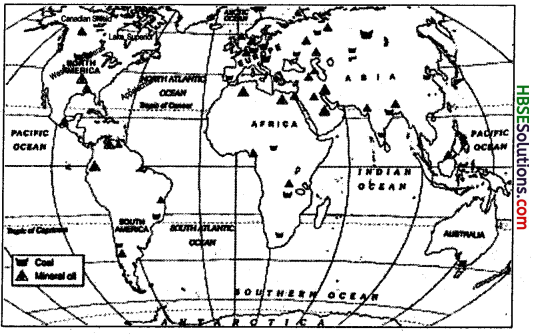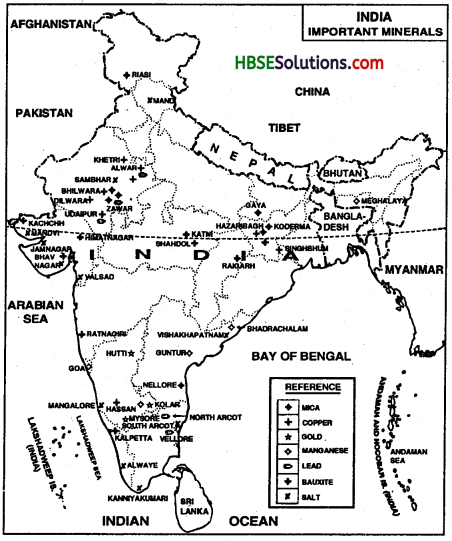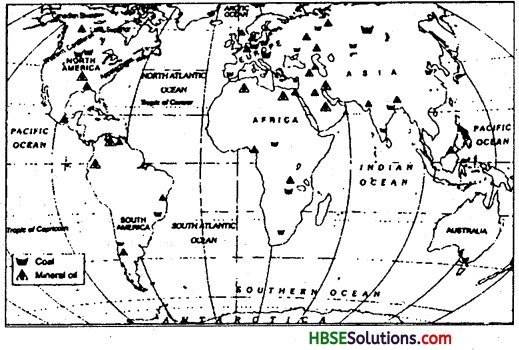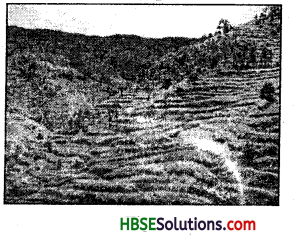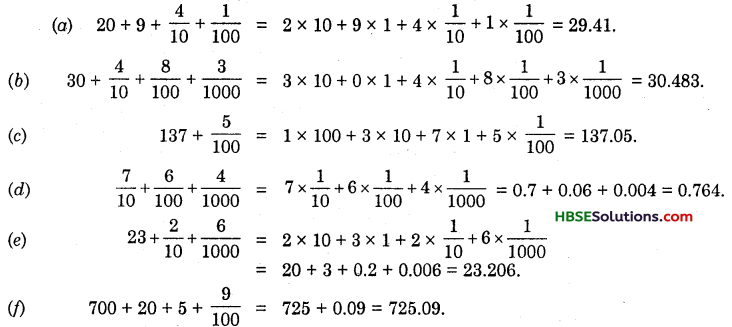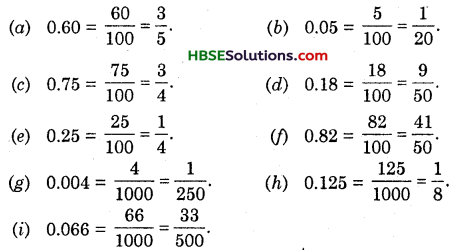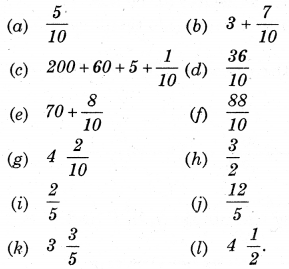Haryana State Board HBSE 8th Class Social Science Solutions Geography Chapter 1 Resources Textbook Exercise Questions and Answers.
Haryana Board 8th Class Social Science Solutions Geography Chapter 1 Resources
HBSE 8th Class Geography Resources Textbook Questions and Answers
LETS DO
List out five resources you use in your home and five you use in your classroom.
Answer:
Resources used in homes:
(a) Natural Resources:
(i) Water
(ii) Air
(iii) Minerals like salt and sugar.
(b) Human Made Resources:
(i) Washing Machine
(ii) Geyser.
Resources used in classroom:
(a) Natural Resources:
(i) Water
(ii) Air
(b) Human Made Resources :
(i) Benches
(ii) Duster
(iii) Computer
ACTIVITY
Question 1.
Circle those resources from Amma’s list that have no commercial values as yet:
Amma’s List : Cotton cloth, Iron ore, Intelligence, Medicinal plants, Medical knowledge, Coal deposits, Beautiful scenery, Agricultural land, Clean environment, Old folk songs, Good weather, Resourcefulness, A good singing voice, Grandmother’s home remedies, affection from friends and family.
Answer:
Old folk songs, Good weather, A good singing voice, grandmother’s home remedies, Affection from friends and family.

LET’S DO
Think of a few renewable resources and mention how their stock may get affected by overuse.
Answer:
Renewable resources: Solar energy, water (hydro) energy, wind energy and to some extent, plants and shrubs. Their stock may get affected by overuse because with increasing population and ever-growing complexity of demands, the rate at which natural resources are being consumed has risen very fast, countries like USA are using the throw away consumption of natural resources.
LET’S DO
Make a list of five human-made resources that you can observe around you.
Answer:
Human-made resources are:
- Roads
- Cars
- Buildings
- Machines
- Refrigerators
Question 5.
What are principles of Sustainable Development?
Answer:
There are some principles of sustainable development. These are:
- Respect and care for all forms of life.
- Improve the quality of human life.
- Conserve the earth’s vitality and diversity.
- Minimise the depletion of natural resources.
- Change personal attitude and practices towards the environment.
- Enable communities to care for their own environment.
EXERCISES
Question 1.
Answer the following questions:
(i) Why are resources distributed unequally over the earth?
(ii) What is resource conservation?
(iii) Why are human resources important?
(iv) What is sustainable development?
Answer:
(i) The distribution of natural resources is unequal because the availability of many physical factors like terrain, climate and altitude also differ very much over the earth. .
(ii) Resource conservation is the careful management and control of resources so that they may continue to be in use.
(iii) Human resources are important because only human resources can make efficient use of resources through proper management and their utilization. They use their knowledge, skill and technology to transfer the natural material into the valuable products.
(iv) The sustainable development refers to the overall development of a nation, especially without damaging its natural resources in such a way that enough resources are available for future generations.
Question 2.
Tick the correct answer:
(i) Which one of the following does not make substance a resource?
(a) utility
(b) value
(c) quantity
Answer:
(c) quantity
(ii) Which one of the following is a human made resource?
(a) medicines to treat cancer
(b) spring water
(c) tropical forests
Answer:
(a) medicines to treat cancer

(iii) Complete the statement:
Biotic resources are
(a) derived from living things
(b) made by human beings
(c) deribed from non-living things
Answer:
(a) derived from living things
Question 3.
Differentiate between the followings:
(a) Potential and actual resources
(b) Ubiquitous and localized resources
Answer:
(a)
| Potential Resources | Actual Resources |
| Potential resources are those resources which are found in a region but are not developed to their full potential. | Actual Resources are those resources which have been developed fully for actual use. |
| For example : Uranium deposits of Ladakh and mineral oil in Rajasthan | For example: Iron, copper etc. |
Potential resources change into actual resources with time. For example, high speed winds were potential resources 200 years ago, but, now these are actual resources.
(ii)
| Ubiquitous Resources | Localised Resources |
| Ubiquitous resources are those resources which are found every where. | Localised Resources are those resources which are found at certain place. |
| For example: The air, the sun etc. | For example : Gold, silver iron, copper etc. |
ACTIVITY
Question 4.
“Rahiman paani raakhiye
Bin paani sab soon,
Paani gaye na ube re Moti, manus, choon
(Says Rahim, keep water, as without water there in nothing. Without water, pearl, swan and dough cannot exist.)
These lines were written by the poet Abdur Rahim Khankhana, one of the nine gems of Akbar’s court. What kind of resource is the poet referring to ? Write in 100 words what would happen if this resource disappeared.
Answer:
The poet refers to the precious resource water. Water is important to all sorts of life. Water is important for the growth of plants, for cooking food, for all sorts of agricultural, industrial and household practices. If this resource disappeared, all the activities would come to a halt. The earth tvill turn to desert and without plants, there will be no life on the earth.
FOR FUN
Question 1.
Pretend that you live in the prehistoric times on a high windy plateau. What are the uses you and your friends could put the fast winds to? Cap you call the wind a resource?
Now imagine that you are living in the same place in the year 2138. Can you put the winds to any use? How? Can you explain why the wind is an important resource now?
Answer:
The wind can be used to generate electricity. Wind can be used in wind-mills.
Wind is a resource. It is a measure of energy.
In the year of 2138 the wind can be used as source of energy. It can be used to generate electricity.
It is an important resource now.
Question 2.
Pick up a stone, a leaf, a paper straw and a twig. Think of how you can use these as resources. See the example given below and get creative!
| You can use a stone …. | use / utility |
| To play stapu | toy |
| As a paper-weight | tool |
| To crush spices | tool |
| To decorate your garden / room | decoration piece |
| To open a bottle | tool |
| In a catapult | weapon |
| |
| You can use a leaf | use/utility |
| |
| |
Answer:
| You can use a stone …. | use/utility |
| To play stapu | toy |
| To decorate the wall | Material |
| To draw picture of tree | tool |
| You can use a straw | Use/utility |
| You can use a straw | use/utility |
| To make picture | tool |
| To feed the animal | fodder |
| |
| You can use a straw | use/utility |
| |
| You can use a twig | use/utility |
| To make fire from dry twin | tool |
| To draw a picture of tree | tool |
HBSE 8th Class Geography Resources Important Questions and Answers
Very Short Answer Type Questions
Question 1.
What is resource?
Answer:
Anything that can be used to satisfy a need is a resource.
Question 2.
Which two factors can change substance into resources?
Answer:
Question 3.
Why do people are important resources?
Answer:
People are important resource because their ideas, knowledge, inventories and discoveries lead to the creation of more resources.

Question 4.
How resources are classified?
Answer:
Question 5.
How natural resources are classified?
Answer:
Natural resources are classified on the basis of their (a) level of development, (b) use, (c) origin, (d) stock, (e) distribution.
Question 6.
In India, where is energy generated by using windmills?
Answer:
- Nagercoil in Tamil Nadu
- Gujarat coast.
Question 7.
What is human resource development?
Answer:
Improving the quality of people’s skills so that they are able to create more resources is known as human resource development.
Question 8.
Mention few ways of conserving resources.
Answer:
- Reducing consumption
- Recycling,
- Reusing.
Short Answer Type Questions
Question 1.
What are natural resources? Give examples.
Answer:
Resources that are drawn from nature and used without much modification are called natural resources. Example: air, water, soils, minerals.
Question 2.
How can resources be classified on the basis of the level of their development? Write one point of difference between them.
Answer:
On the basis of the level of development, resources can be classified into two groups : actual resources and potential resources. Actual resources are those whose quantity is known wheras the entire quantity of potential resources may not be know.
Question 3.
Distinguish between abiotic and biotic resources.
Answer:
Abiotic resources are non-living. Example : soils, rocks and minerals.
Biotic resources are living. Example: plants and animals.
Question 4.
What are human made resources?
Answer:
People use natural resources to make buildings, bridges, roads, machinery and vehicles. These are known as human made resources.

Question 5.
What is the difference between resource conservation and sustainable development?
Answer:
Using resources carefully and giving them time to get renewed is called resource conservation. Balancing the need to use resources and also conserve them for the future is called sustainable development.
Long Answer Type Questions
Question 1.
What are the different types of values resources may possess?
Answer:
Resources may possess different values as :
(i) Economic Value : The resources (raw- materials) which are used in the manufacture of other useful products have economic value, e.g,, means of irrigation, coal, petroleum.
(ii) Aesthetic Value: The high mountains, the waterfull, natural sceneries all have aesthetic value for us.
(iii) Ethical Value : The ethical and moral values refer to the principles of love and care for the family, care of flora and fauna, preserving natural parks etc.
(iv) Legal Value : The laws passed by the government from time-to-time and the provi¬sions of the constitution have legal value.
Question 2.
Why is there a difference in the level of development of different regions/hations? What are the different methods which have to be observed to increase the level of productivity?
Answer:
There is a difference in the level of development of different regions because
- the resources are not distributed equally.
- the skills and technology possessed and used by human beings varies for different human beings.
The level of productivity can be increased if:
- all the available resources are identified.
- technology and skills should be used immensely and efficiently for practical purposes.
- conservation of resources is done. The ever increasing population can put a great stress on the economic development of a nation.
- government should pass effective law and order so that the resources of a nation are optimally used.
- human population of a region/nation is healthy and productive.
- the national and international cooperation for the use of resources.
Picture Based Questions
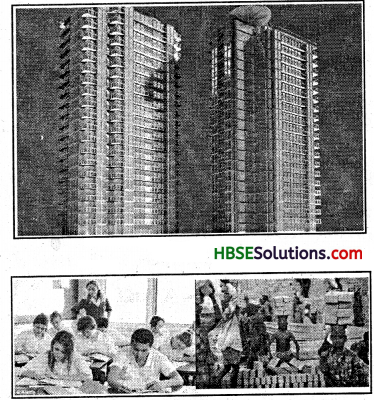
Question 1.
What type of resource is depicted in picture 1.1?
Answer:
Human-made resource.
Question 2.
What type of resources is depicted in picture 1.2?
Answer:
Human resources.
Question 3.
Which of the two types of resources is more important and why?
Answer:
Human resources are more important as they are capable of making the best use of natural resources through their knowledge, skill and technology. Only human beings can discover, exploit, develop and convert the available or potential resources into useful products.
Resources Class 8 HBSE Notes
- Resource : Anything that can be used to satisfy a need.
- Patent: It means the exclusive right over any idea or invention.
- Technology: It is the application of latest knowledge and skill in doing or making things.
- Stock of Resource : It is the amount of resources available for use.
- Bio-Gas : Gas made from organic wastes.
- Human-made Resources: The resources that are created from the natural substances by the human beings to produce valuable products.
- Human Resources : This means the number and ability of the people.
- Conservation: Careful management and control of resources so that they may continue to be in use.
- Sustainable Development : Sustainable Development ensures that the existing resources are used in a manner that enough is left for the generations to come.
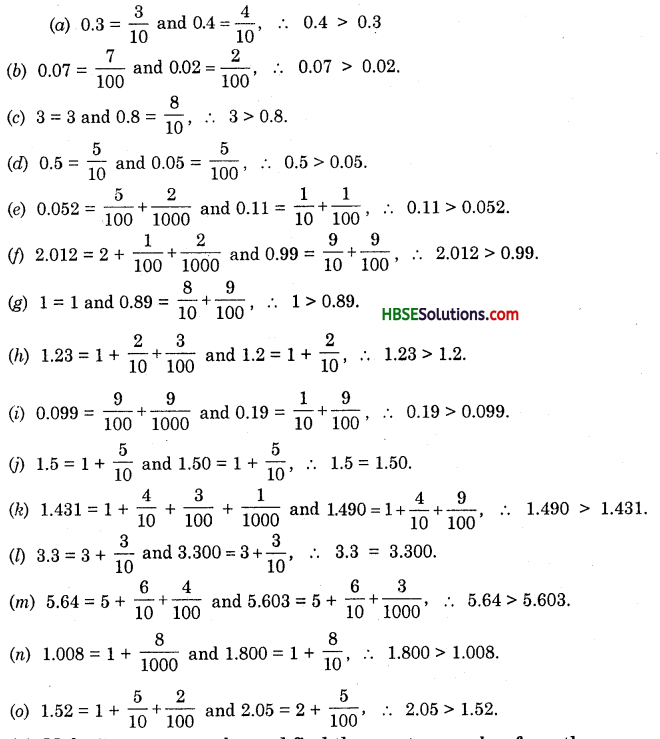
![]()
